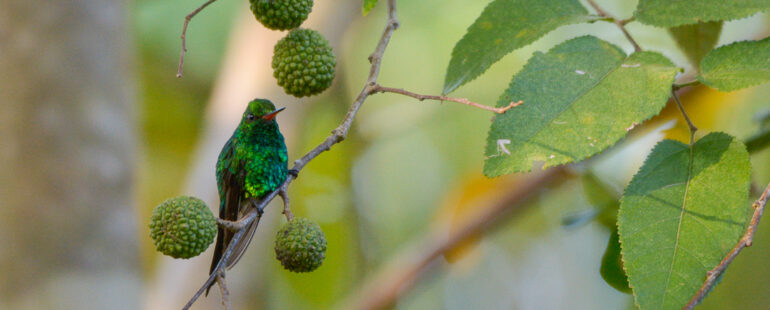14 days of filming bird videos for BirdFun YouTube channel around the Yucatan Peninsula!
This 14-day birding tour was designed specifically to visit some of the best hotspots around the Yucatan Peninsula that would give us chances to make good videos of lots of birds, including all of the endemics and specialties, in addition to the resident and migratory species.
Our adventure started on November 14th, I left Merida and drove to pick up Udo Rijlaarsdam who was staying at Holbox doing a break between tours in Mexico, he took the ferry and got to Chiquilá where we met. We drove to the Cozumel ferry terminal, waited patiently and got to the island in the afternoon. That day we went for shrimp tacos and then to sleep early so we would be ready for birding the next day.
Cozumel Island Birding.
For our first morning at Cozumel, we drove towards El Cedral (the best birding hotspot on the island), bird activity was amazing, as we had not only great views of many of the endemic species like the Cozumel Bananaquit, Cozumel Vireo and Black Catbird but also many migratory warblers including a not so common Prairie Warbler.
Some highlights from the morning at El Cedral include: Green-breasted Mango, Cozumel Emerald, Yucatan Woodpecker, Yellow-bellied Elaenia, Tropical Kingbird, Cozumel Vireo, Yucatan Vireo, Blue-gray Gnatcatcher (Cozumel), Black Catbird, Gray Catbird, Western Spindalis, Worm-eating Warbler, Cape May Warbler, Yellow Warbler (Golden), Palm Warbler, Yellow-throated Warbler, Rose-throated Tanager, Northern Cardinal, Rose-breasted Grosbeak and Yellow-faced Grassquit.
After a very productive morning with a list of 50+ species seen and heard, we went to the ponds south on the island, there were not that many birds but we added some species to the list, including Blue-winged Teal, American Coot, Black-necked Stilt, Northern Jacana, Great Egret, Little Blue Heron and Turkey Vulture.
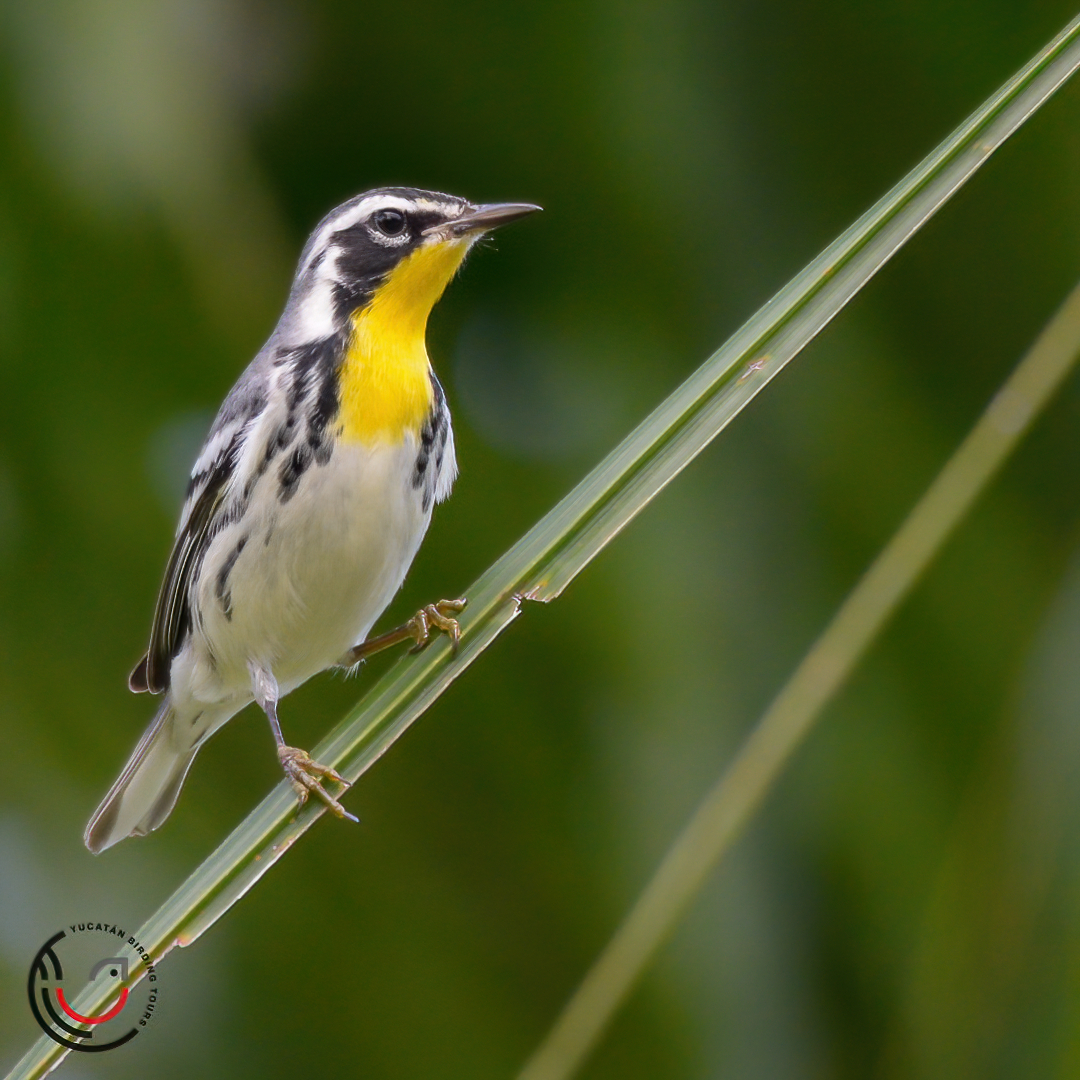
Yellow-throated Warbler (Setophaga dominica).
For the afternoon of that day, we spent a couple hours birding at two different hotspots, unfortunately the weather was not very helpful for birding but we still managed to pull some new birds for the list, including: Ruddy Ground Dove, Merlin, Couch's Kingbird, Black-throated Green Warbler, Gray Hawk, Olive-throated Parakeet, Northern Rough-winged Swallow, Common Yellowthroat and Morelet's Seedeater.
The next day we went to El Cedral again as it was designed on our schedule and it didn't disappoint as we had superb views of the male Cozumel Emerald and there's a YouTube video to prove that!
Cozumel Emerald YouTube Video by BirdFun
Some of the highlights of the morning also include: White-crowned Pigeon, Groove-billed Ani, Green-breasted Mango, Black Vulture, White-fronted Parrot, Yucatan Vireo, House Wren (Cozumel I.), Hooded Oriole, Ovenbird, Tennessee Warbler, American Redstart, Northern Parula, Magnolia Warbler, Summer Tanager, Blue Grosbeak, Indigo Bunting, Painted Bunting and Yellow-faced Grassquit.
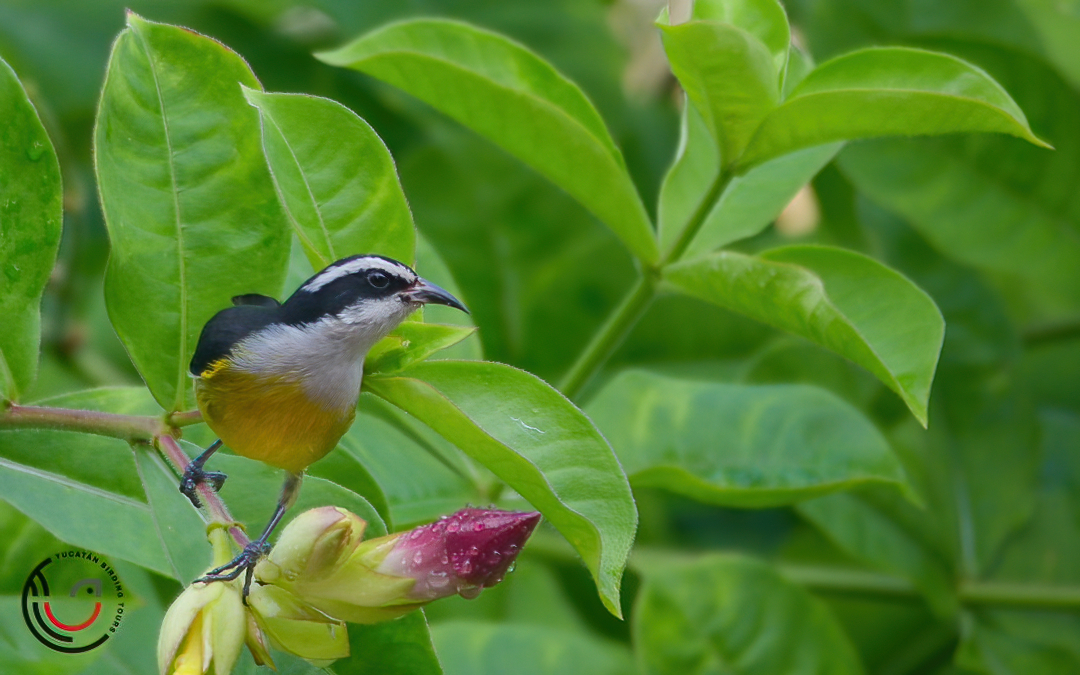
Cozumel Bananaquit (Coereba flaveola caboti) at El Cedral, Cozumel.
We returned to our hotel and got ready for our ferry. We got to the mainland around 3 pm and then we drove towards Felipe Carrillo Puerto with a stop at the Muyil Archaeological Site.
We walked for about 1 km and less than an hour and we pulled almost 30 bird species including: Vaux's Swift, Green Heron, Lineated Woodpecker, Olive-throated Parakeet, Olivaceus Woodcreeper, Ivory-billed Woodcreeper, Northern Bentbill, Yellow-olive Flycatcher, Great Kiskadee, Social Flycatcher, Brown Jay, Green Jay, Altamira Oriole and Red-throated Ant Tanager.
Muyil Archaeological Site.
We got to Felipe Carrillo Puerto, went for dinner and after that to sleep and get ready for the next day.
Kohunlich Archaeological Site.
We left Felipe Carrillo Puerto for a two hour drive towards the Kohunlich Archaeological Site. We started birding on the road to the site and found some interesting birds like a group of 25 Rose-breasted Grosbeaks, a Northern Waterthrush, Ferruginous Pygmy-Owl, Dusky-capped Flycatcher, Lesser Greenlet, Black-headed Saltator and many migratory warblers.
Then we got to the archaeological site and we walked around the area for about 2 hours. This is not a reallly popular archaeological site for tourists so we, prety much, had the place for us alone and bird activity was really good. The only bad thing of that day was the fact that the employees did not allow us to take the tripod with us so we were not able to make any videos. Anyways, we got some great birds and some of the highlights include: Red-billed Pigeon, Gray Hawk, Black-headed Trogon, Lesson's Motmot, Collared Aracari, Pale-billed Woodpecker, Lineated Woodpecker, Chesnut-colored Woodpecker, Bat Falcon, Red-lored Parrot, Ivory-billed Woodcreeper, Masked Tityra, Eye-ringed Flatbill, Yellow-throated Euphonia, Louisiana Waterthrush, Blue Bunting, Black-headed Saltator.
Pale-billed Woodpecker (Campephilus guatemalensis) at the Kohunlich Archaeological Site.
Calakmul Biosphere Reserve
After a very productive morning, we left the site and drove towards the Calakmul Biosphere Reserve for lunch and resting and then birding at our hotel's surroundings in the afternoon.
We were welcomed by some Plain Chachalacas eating Chicozapote (Manilkara zapota), and we also got some other interesting birds like Keel-billed Toucan, Rose-throated Becard, Great-crested Flycatcher, Boat-billed Flycatcher, Clay-colored Thrush, Yellow-throated Euphonia, Hooded Warbler, Magnolia Warbler and Black-headed Saltator.
Boat-billed Flycatcher (Megarynchus pitangua) at the Chicanná Ecovillage Resort.
The next day, we drove towards the Calakmul Archaeological Site with our main target being the Ocellated Turkey, so, as soon as we got to the site's entrance, we paid our fees and drove until we found our first turkeys. It didn't take long, as after reaching the CONANP entrance, we found 5 really friendly Ocellated Turkeys (and when I say friendly I really mean it, see picture below).
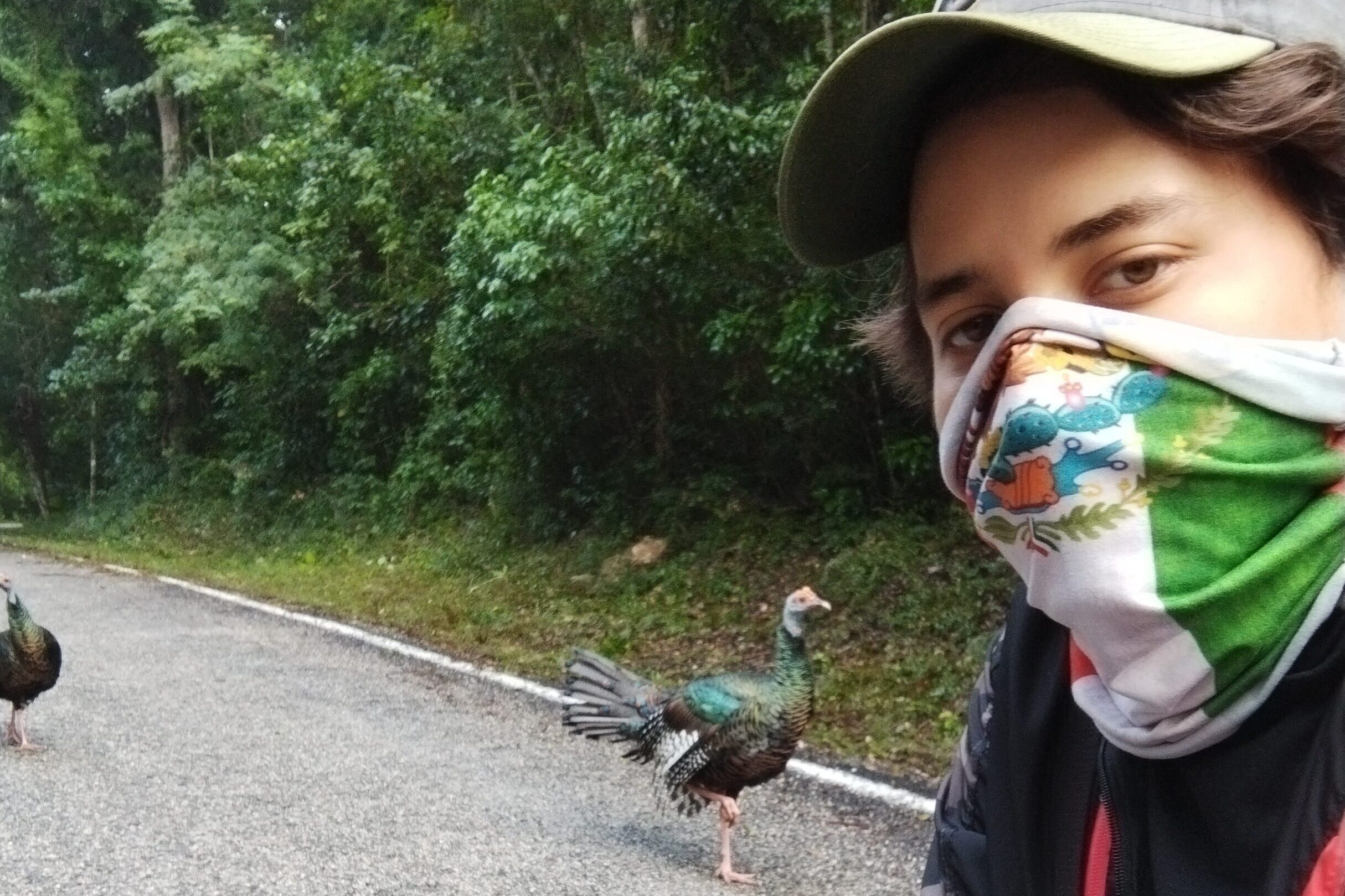
Ocellated Turkeys (Meleagris ocellata) posing for selfies.
At our first stop we also found Gartered Trogon, Collared Aracari, Northern Bentbill and Brown-crested Flycatcher.
Our second stop was at the ponds on the road to the site, there we came across some other birders and after a little chat about our findings we got some great birds including: Wedge-tailed Sabrewing, Keel-billed Toucan, Barred Forest-Falcon, Bat Falcon, Northern-barred Woodcreeper, Masked Tityra, Northern Bentbill, Eye-ringed Flatbill, Yellow-olive Flycatcher, Yellow-bellied Flycatcher, Yellow-throated Vireo, Green-backed Sparrow, Worm-eating Warbler and Red-throated Ant-Tanager.
Our third and last stop of the day was at the ruins of Calakmul, where we spent about three and a half hours and walked a little more and 3.5 km, getting a list of 32 bird species seen and heard. Some of the highlights include: White-bellied Emerald, Limpkin, Slaty-tailed Trogon, Black-headed Trogon, Olivaceus Woodcreeper, Bright-rumped Attila, Great-crested Flycatcher, Boat-billed Flycatcher, Orange Oriole, Altamira Oriole, Louisiana Waterthrush and Black-headed Saltator.
Slaty-tailed Trogon (Trogon massena) at the Calakmul Archaeological Site.
The next day we went to the Hormiguero Archaeological Site. We left our hotel, made a stop for coffee and drove towards the ruins. On the road to the ruins we spotted some really nice birds like the Baltimore Oriole, Yellow-tailed Oriole and Blue-black Grassquit. But the true spectacle started when we arrrived to the dirt road of the archaeological site, we stopped and started filming a pair of Least Grebes when I noticed that there was something perched on a big dead tree, can you guess what? Look at the picture below.
Ornate Hawk-Eagle (Spizaetus ornatus) at El Hormiguero Archaeological Site.
Yes, we had an Ornate Hawk-Eagle putting on a 1-hour show of preening, stretching and scratching for us (or maybe even more time if we didn't have more birds to see). While Udo (BirdFun) was getting more than one hour of Hawk-Eagle footage, we got some other highlights including: Squirrel Cuckoo, Wedge-tailed Sabrewing, White-bellied Emerald, Common Gallinule, Gartered Trogon, Yellow-lored Parrot, Carolina Wren, Spot-breasted Wren and White-bellied Wren.
Ornate Hawk-Eagle YouTube Video by BirdFun
After way too many "just a couple minutes more" with the eagle, we drove to the ruins and started walking on the trails. Bird activity was okay considering that we spent the best window of time getting superb views of one of the most beautiful raptors of Mexico, but it got really good when we took some really narrow trails and we came across a male Red-capped Manakin chasing a female, a mixed flock of Red-crowned Ant-Tanagers, Golden-crowned Warbler, Green-backed Sparrow and Spot-breasted Wren. Some other highlights from the ruins include: Scaled Pigeon, Crane Hawk, Collared Aracari, Olivaceus Woodcreeper, Greenish Elaenia, Rose-throated Tanager.
We returned for lunch and a little rest and took a walk around the hotel in the afternoon, we got REALLY LUCKY as we found a group of endemic Yellow-lored Parrots feeding on seed pods. Yellow-lored Parrots are hard to see perched and they are really shy birds, so getting the chance to see them from that close, showing some of their behaviour, feeding and vocalizing was glorious, the fact that Udo got amazing footage on this, was the icing on the cake.
Yellow-lored Parrot YouTube Video by BirdFun
While the Yellow-lored Parrots definitely stole the show, we also came across some other really nice birds like Squirrel Cuckoo, Turquoise-browed Motmot, Olive-throated Parakeet, Black-crowned Tityra, Rose-throated Becard, Least Flycatcher, Boat-billed Flycatcher, Brown Jay and Summer Tanager.
We had one more morning in the area, and we decided that it was worth taking a walk around the hotel before leaving towards Mérida. It was worth, as we managed to get some footage of new birds for the trip like Olive-throated Parakeet, Black-cowled Oriole and Yellow-winged Tanager.
Mérida.
We got to Mérida went for lunch at the coast and then birding. We took a road that goes across a swampy area with lots of mangrove trees, and that was where we found our first American Flamingos and of course we added lots of new birds for the trip, some of the highlights include: Black-bellied Plover, Semipalmated Plover, Ruddy Turnstone, Stilt Sandpiper, Lesser Yellowlegs, Caspian Tern, Royal Tern, Sandwich Tern, Reddish Egret, Roseate Spoonbill, Crested Caracara and Belted Kingfisher.
Then, for our last stop of the day, we went to the harbor to see and film all of the birds that go to roost there. We got a good mixed group of Black-necked Stilts, American Avocets, Marbled godwits, Sanderlings, Laughing Gulls, Franklin's Gulls, Forster's Terns, Black Skimmers and Brown Pelicans.
Marbled Godwits (Limosa fedoa) in the background, Laughing Gulls (Leucophaeus atricilla) and Black Skimmers (Rynchops niger) in front.
The next day, we went to a road with a mixture of pastures and dry forest, spending a little more than two hours and getting some great birds like the Black-throated Bobwhite, Common Ground Dove, Groove-billed Ani, Lesser Roadrunner, Squirrel Cuckoo, Cinnamon Hummingbird, a rare Cooper's Hawk, Red-tailed Hawk, Turquoise-browed Motmot, American Kestrel, White-fronted Parrot, Brown-crested Flycatcher, Rufous-browed Peppershrike, Mangrove Vireo, Yucatan Jay, Yucatan Gnatcatcher, Olive Sparrow, Hoded Oriole, Orange Oriole and Cinnamon-bellied Saltator.
Squirrel Cuckoo (Piaya cyana) near Mérida.
We left the road and drove to the coast, now looking for the Mexican Sheartail and the Yucatan Wren, which we did see and filmed. We also saw a Greater Yellowlegs, Double-crested Cormorants, Brown Pelicans, Osprey, Tropical Mockingbird and Northern Cardinal.
On our way back to Mérida we were lucky enough to come across a group of 5 Ocellated Turkeys and also a couple Lesser Roadrunners.
Valladolid Area.
After a morning birding in Merida, we left the city and drove towards Piste, where we would stay for two nights. We arrived to our hotel around 1:00 PM, had lunch and took a little break. After a couple hours we went out again to look for birds a the hotel's birding trail. Some highlights include: Ferruginous Pygmy-Owl, Turquoise-browed Motmot, Masked Tityra, Tropical Pewee, Boat-billed Flycatcher, Yucatan Jay and Altamira Oriole.
The next day we left our hotel and drove for 25 minutes towards a birding trail that has a combination of crops and tropical semihumid forest. It was really birdy and we started with a young Gray Hawk catching the sunlight which made a group of more than 20 Yucatan Jays get angry and very noisy, after that, we also found a Lineated Woodpecker looking for insects on dead trees and a beautiful male Canivet's Emerald preening for some good couple minutes, really making honor to its name. Some other highlights of that spot include: Ruby-throated Hummingbird, Roadside Hawk, Turquoise-browed Motmot, Rose-throated Becard, Tropical Pewee, Black Catbird, Scrub Euphonia, Olive Sparrow, Orange Oriole, Bronzed Cowbird and Rose-throated Tanager.
Yucatan Jay (Cyanocorax yucatanicus) at the Valladolid Area.
After that, we went to another birding trail to add some more birds to the list. We got some really nice views of many species including: Green-breasted Mango, Wedge-tailed Sabrewing, Buff-bellied Hummingbird, Lesson’s Motmot, Turquoise-browed Motmot, Ivory-billed Woodcreeper, Yucatan Flycatcher, Dusky-capped Flycatcher, Yellow-throated Vireo, Yellow-throated Euphonia, Hooded Warbler, Rose-throated Tanager, Northern Cardinal, Indigo Bunting, Blue-black Grassquit and Yellow-faced Grassquit.
In the afternoon, we walked on the hotel’s birding trail, we didn’t see that many new birds, but got some footage of Black-headed Saltators and Turquoise-browed Motmot.
At night we tried for nightbirds, we got a Middle American Screech-Owl really close but it never came out for us to see it.
For our last day at the Valladolid area, we went to the spot where we saw the Gray Hawk, looking to get some more footage of some different species. Highlights from our last morning at the area include: Ruby-throated Hummingbird, Roadside Hawk, Turquoise-browed Motmot, Yellow-lored Parrot, Olivaceus Woodcreeper, Rufous-browed Peppershrike, White-eyed Vireo, Mangrove Vireo, Brown Jay, Green Jay, Yucatan Jay, Black Catbird, Orange Oriole, Magnolia Warbler, Black-throated Green Warbler and Rose-breasted Grosbeak.
Male Orange Oriole (Icterus auratus) preening.
Rio Lagartos Biosphere Reserve.
We left our hotel at the Valladolid area and drove for a couple hours towards Rio Lagartos, we did a little birding on the road while we were driving towards our hotel, finding some really interesting birds like: Blue-winged Teal, Russet-naped Wood-Rail, American Coot, Purple Gallinule, Northern Jacana, Solitary Sandpiper, both Greater and Lesser Yellowlegs, Wood Stork, Anhinga, Bare-throated Tiger-Heron, Glossy Ibis, Lesser Yellow-headed Vulture, Belted Kingfisher, Crested Caracara and Vermilion Flycatcher.
Then, after lunch and a break, we went to a small trail inside the mangrove forest, where we found quality over quantity, a Common Black Hawk, Yellow-backed Oriole, Yellow-tailed Oriole and a Melodious Blackbird. Plus two Morelet’s Crocodiles. Later, we took the same road we used to get to Rio Lagartos and we found a Sora and a Laughing Falcon.
Laughing Falcon (Herpetotheres cachinnans) at the Rio Lagartos Biosphere Reserve.
The next day, we drove towards el Cuyo, looking for a Sandhill Crane that was reported on the area. We didn’t find it, but instead we had a very productive morning finding tons of great birds including: Black-bellied Whistling-Duck, Fulvous Whistling-Duck, American Flamingo, Least Grebe, Pied-billed Grebe, Purple Gallinule, Limpkin, Anhinga, Least Bittern, Black-crowned Night-Heron, Crane Hawk, Snail Kite, Gray Hawk, Belted Kingfisher, Crested Caracara, Vermilion Flycatcher, Mangrove Swallow, Red-winged Blackbird, Bronzed Cowbird, Palm Warbler and Cinnamon-bellied Saltator.
Fulvous Whistling-Duck (Dendrocygna bicolor) in a group of Black-bellied Whistling-Ducks (Dendrocygna autumnalis) at the Rio Lagartos area.
We went back to Rio Lagartos for lunch and while eating and looking at birds from the restaurant we found a group of American Oystercatchers, some American White Pelicans and some Magnificent Frigatebirds.
In the afternoon we drove towards another small trail inside a mangrove forest patch to look for American Pygmy Kingfisher. We spent about 40 minutes walking on the trail and just when we started thinking that we were going to return to our hotel without any success, Udo told me “look! Pygmy Kingfisher!” and there it was, the American Pygmy Kingfisher just sitting there in the shadows without doing any movements.
American Pygmy Kingfisher YouTube Video by BirdFun
So after getting some really good footage of the Kingfisher, we drove back towards Rio Lagartos and on the road we came across a small mixed group of a male Blue-winged Teal, Sora, Black-necked Stilt, Northern Jacana, Least Sandpipers, Lesser Yellowlegs and a Glossy Ibis.
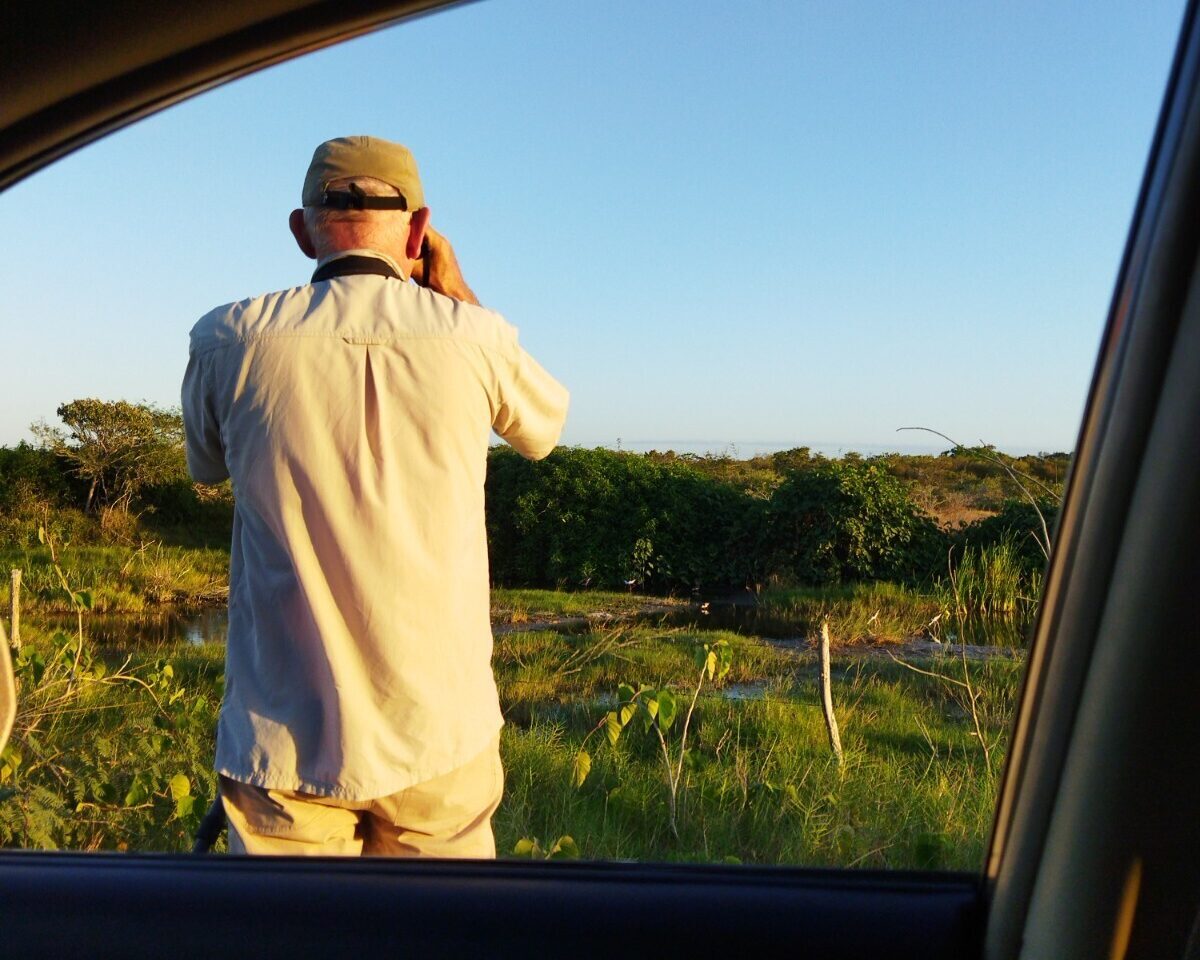
Udo filming birds at the Rio Lagartos Biosphere Reserve.
Merida.
The next day we left Rio Lagartos and drove towards Merida taking the coastal road. While driving, we came across a group of 8 Ocellated Turkeys. Then we got to the coast and started making stops whenever we saw good bird activity. Some highlights from the morning include: Lesser Roadrunner, Black-bellied Plover, Sanderling, Spotted Sandpiper, Willet, Lesser Black-backed Gull, Caspian Tern, Royal Tern, Little Blue Heron and Reddish Egret.
In the afternoon we went to the coast again, now to a really birdy salt pond area. It was really windy but we still managed to pull some interesting birds including: American Flamingo, American Avocet, Snowy Plover, Wilson’s Plover, Semipalmated Plover, Killdeer, Ruddy Turnstone, Stilt Sandpiper, Dunlin, Semipalmated Sandpiper, Western Sandpiper, Gull-billed Tern, Caspian Tern, Reddish Egret, Roseate Spoonbill, Osprey and Mangrove Swallow.
Reddish Egret (Egretta rufescens) at the Salt Ponds.
The next day, we went back to the first spot where we saw the Bobwhites, trying to see if we could get some more footage on this species, unfortunately, they were not cooperative, but we got some other interesting birds that morning, including: Squirrel Cuckoo, Cinnamon Hummingbird, Red-tailed Hawk, Yucatan Woodpecker, Barred Antshrike, Northern Beardless-Tyrannulet, Brown-crested Flycatcher, Yucatan Flycatcher, Mangrove Vireo, Yucatan Jay, Yucatan Gnatcatcher, Carolina Wren, Gray Catbird, Altamira Oriole, Black-throated Green Warbler and Cinnamon-bellied Saltator.
Later that day, we headed to the coast, making a stop for Clapper Rails and then to scan a mixed group of Marbled Godwits, Red Knots, Sanderling, Western Sandpiper and Laughing Gulls.
In the afternoon we went back to the same spot, as we noticed that all of the birds would roost at a certain spot, so it was going to be really good to film video. On our way to the birding place, we spotted a Red-breasted Merganser which is not really common in the Yucatan Peninsula. After that, we didn’t see anything new for the list, but the afternoon was really nice and there was lots of birds just preening and getting ready to rest.
Red-breasted Merganser (Mergus serrator) at the Sierra Papacal-Chuburna road.
On our way back to Merida, we were really lucky and we found a very cooperative Russet-naped Wood-Rail eating for some good minutes, such a colorful bird!
Sisal.
For our last day we went to Sisal, a port on the west coast of the Yucatan state. We drove along a dirt road that has a combination on mangrove forest on one side and a small savanna on the other side. We got lucky as we found a group of 7 Black-throated Bobwhites eating on the ground very calmly, which of course translated into great footage. We got really good bird activity on the dirt road, some highlights include: Zenaida Dove, Mexican Sheartail, Cinnamon Hummingbird, Green Heron, Turquoise-browed Motmot, Crested Caracara, Dusky-capped Flycatcher, Mangrove Vireo, Yucatan Wren, Tropical Mockingbird, Orchard Oriole, Hooded Oriole and Northern Parula.
Black-throated Bobwhite YouTube Video by BirdFun
Turquoise-browed Motmot (Eumomota superciliosa) at Sisal.
For our last afternoon, we went to the Bobwhite road one last time, this time, not for the bobwhites but for a good video of Boat-billed Flycatchers, which never showed up, but instead we got to see a Gray Hawk feeding on a recently killed Cattle Egret. As we didn’t have any success with the flycatchers, we moved to another spot, there we added our last “new for the trip” bird, a Peregrine Falcon and that’s how this amazing trip concluded, with a big list of amazing birds and lots of video for YouTube.
Here’s the link to Udo’s YouTube Channel so you can see videos from this trip and many more that he’s been doing for quite some time now:
Written by Luis Trinchan Guerra






